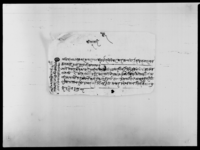A copy of a letter from Jaṅga Bahādura ordering the protection of forests on land belonging to Śrī Bhagavatī of Palāñcoka (VS 1906)
ID: K_0580_0004
Edited and
translated by Rajendra Shakya
Created: 2018-01-11;
Last modified: 2018-11-26
For the metadata of the document, click here
The accompanying edition, translation/synopsis and/or commentary are available under the terms of the Creative Commons Attribution-ShareAlike 4.0 International License
Abstract
The document contains an order restricting the cutting down of trees in a protected forest belonging to the Palāñcoka Bhagavatī temple, and instructing the amālī to investigate and punish anyone who does so.Diplomatic edition
[1r]
1श्री\ 1श्रीभगवती2१[Seal with the inscription "Śrī Ṣaḍānanda 72"]1सकलवमोजीम्नकलदुरुस्तछ
2भनीसकलवुझीनकल्मास्हीछा
3पगर्नेपुजाहारीषडानन्दगुभा
4जु1स्वस्तिश्रीमद्राजकुमारकुमारात्मजश्रीप्राईममिनिष्टरयान्कम्यांडरईनचीफजनरलज
2ङ्गवाहादुरकुव़रराणाजीकस्यपत्रम्¯¯¯ ¯¯¯ ¯¯¯ ¯¯¯ ¯¯¯ ¯¯¯ ¯¯¯ ¯¯¯
3आगेपलाम्चोककाथरीमुषीयाभला[?]नीसप्रधानगौरुंरैतिगैह्रकेयेथोचीत्उप्राँत
4ताहाको¯ ¯१¯काफुलवारीवन्रधारापानिषेतकाकुलोकोसिर्हांकोअघीदेषीपा
5लीआयाकोवन्जस्लेकाटनुफाड्नुगर्लातस्लाईअमालिलेजाचवुझगरीडंड
6गर्नुभंन्याअयन्कोदस्षत्गर्नदिञ्यूईतिसम्वत्१९०६सालमितीवैशाषसु
7दी२रोज३शुभ्म्¯¯¯ ¯¯¯ ¯¯¯ ¯¯¯ ¯¯¯ ¯¯¯ ¯¯¯ ¯¯¯
Translation
[1r]
Śrī Bhagavatī – 1
[Seal with the inscription "Śrī Ṣaḍānanda [18]72"]1
Having received the original, the priest Ṣaḍānanda Gubhāju2 puts [his] seal to the copy in attestation that the copy is true to the original.
Hail! A letter from Prime Minister and Commander-in-Chief General Jaṅga Bahādura Kũvara Rāṇā, the venerable prince born of a prince.
Āge: To the elders (tharī), headmen (mukhiyā), respected persons (bhalā mānisa), pradhānas, village agents (gauruṅ), landholders (raitī) and all others of Palāñcoka.
Yathocita uprānta: We have issued [lit. allowed to be signed] a directive that instructs the amālī to launch an investigation of and punish anyone there who cuts [flowers] in the garden(s) or clears forestland belonging to [Śrī Bhagavatī]3 , or forestland above the Dhārāpānī Kheta irrigation channel that has remained protected since times past.
Tuesday, the 2nd of the bright fortnight of Vaiśākha in the [Vikrama] era year 1906 (1849 CE). Auspiciousness.
Commentary
It is unclear what specifically, if anything, prompted Jaṅga Bahādura to take measures to protect land set aside for Palāñcoka Bhagavatī. It is interesting that Ṣaḍānanda Gubhāju, the temple priest, has a seal of his own, though this is perhaps not so surprising, given the temple’s renown. The number 72 may be an abbreviated form of VS 1872, the year the priest possibly began to serve the deity or else was first authorized to use a seal of his own.
Situated some 50 km east of Kathmandu, Palāñcoka Bhagavatī is one of a quartet of Bhagavatī temples, the others being Naksāla Bhagavatī and Śobhā Bhagavatī in Kathmandu and Nālā Bhagavatī in Kabhrepalāñcoka District. A popular legend credits the creation of all four figures to the same artist, who first attended to the Palāñcoka Bhagavatī. The result was a masterpiece, and hence his fingers were cut in an attempt to prevent him from creating a duplicate. But he still managed to create the other three, even after losing his fingers and then an arm each after creating the third and the fourth figures (Slusser 1998: I, 309–310). M. Slusser believes that the figure of Naksāla Bhagavatī "is almost certainly a work of the twelfth or thirteenth century, while the Palanchok and Sobhā Bhagavatī images are both products of the period of the Three Kingdoms. The Nala image is undatable" (ibid.: 310), but she presumes that it belongs to the same period as the Naksāla Bhagavatī, as both closely compare with each other in size and form.

